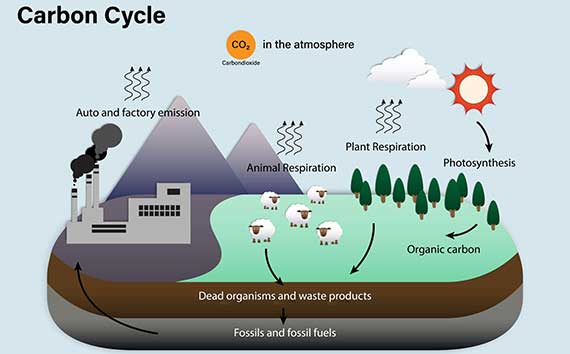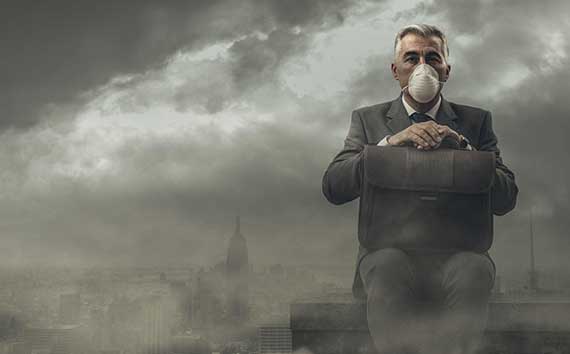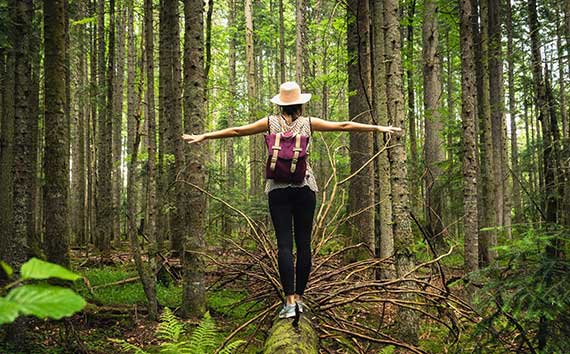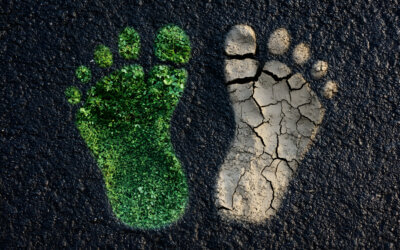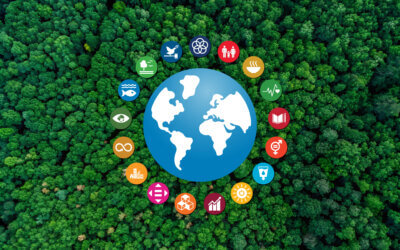Carbon has been called the building block of life.
A non-metallic chemical element, carbon is present in all living things, plants and animals. It is found throughout the biosphere, in fats, sugars, proteins, and DNA.
Carbon is also present in the non-living world all around us. It exists in the atmosphere in the form of carbon dioxide (CO2). It is dissolved into the hydrosphere, into the oceans, lakes, rivers, and streams. And it is found beneath our feet in the geosphere, in the soil, in rocks, and in the form of fossil fuels, such as oil and coal.
Carbon moves between these “spheres” through various processes, together called the Global Carbon Cycle. The balance of this cycle is critical for the continuation of life on the planet Earth.
But this cycle is not static. It fluctuates, and it is vulnerable to change, both through natural events, like volcano eruptions or the weathering of the earth’s surface, and through anthropogenic — or human-originated activities — like clear-cutting forests and the burning of fossil fuels.
With the human population growing exponentially and such activities occurring with greater and greater frequency, there is now more atmospheric CO2 “than at any time in the last 3.6 million years,” according to the National Oceanic and Atmospheric Administration (NOAA).
This sudden atmospheric saturation is accelerating climate change to the extent that advocates are raising the alarm, calling on individuals, corporations, and nations to minimize and end this global climate fiasco.
Even as we seek to know more about the science of the changing global carbon cycle, concerned “citizens,” in our many forms, are responding. We are changing behaviors to reduce carbon emissions, acting to reforest our communities, and working to offset the carbon footprints that are still left behind as we walk through the modern world.
What Is the Global Carbon Cycle?
At its most basic, the global carbon cycle can be described as the flow of carbon molecules through the various “spheres” and natural ecologies of the earth. Traditionally, it has been illustrated as the movement of carbon through:
- Photosynthesis: When inorganic carbon is transferred from the atmosphere to plants or plankton, providing food for plant growth
- Ingestion: When mostly organic carbon is passed from plants to animals through participation in the food chain
- Respiration: When carbon moves from plants and animals into the atmosphere, being released back into the air when they breathe
- Decomposition: When carbon passes into the earth as organic matter decays and is broken down into soil, possibly turning into fossil fuels millions of years into the future
But the global carbon cycle is more complicated than a single uninterrupted circle of basic processes. It does not have a specific start point nor a well-defined end point. And carbon moves in and out of more than one biogeochemical cycle and in varying time scales.
Carbon circulates within the earth. It is absorbed deep into the earth’s mantle, through burial or subduction. It is then degassed through geologic events, like the moving of tectonic plates. It can be released back into the atmosphere when magma erupts above the earth’s surface, through the act of volcanism.
Carbon also flows in and out of the water cycle through dissolution and evaporation. It is absorbed into the oceans or other bodies of water and then returns to the atmosphere during heating and cooling events.
And carbon is released into the atmosphere, attaching to oxygen and forming carbon dioxide, through the process of burning, or combustion.
Combustion can occur through natural events, such as lightning-caused wildfires. But it is most frequently tied to human activities, such as when fossil fuels are burned in our car engines, when factories produce goods for us to buy, or in the process of heat and electricity generation.
Why Is the Global Carbon Cycle Important?
When we think about the role the global carbon cycle plays in such necessary processes as eating, breathing, and returning to the earth from whence we came, it is easy to see how important it is for life. Carbon is more than just the foundation for life; it is what nourishes and sustains life.
But when the Earth’s systems become unbalanced through a disrupted carbon cycle — increased carbon emissions and reduced carbon uptake — it can also mean significant concern for life as we know it.
The bulk of carbon on Earth is sequestered in rocks, nearly 65,500 billion metric tons, according to NASA’s Earth Observatory. More is held by carbon pools in the deep ocean or is trapped in the ice core, leaving a record of ancient carbon sequestration.
The remaining soil carbon, ocean carbon, and atmospheric carbon flows naturally between the atmosphere, hydrosphere, and biosphere. Over the long term, it tends to find itself in a relative balance.
In this state, atmospheric carbon helps to regulate the Earth’s temperature.
When the amount of carbon moving in and out of the atmosphere remains mostly unchanged, the global temperature is also relatively stable. However, when there is a large atmospheric carbon flux, the terrestrial biosphere is impacted and temperatures can also shift dramatically.
When there is less carbon dioxide in the atmosphere, there is a cooling effect on global temperatures. Water vapor condenses and falls back to earth in the form of rain, snow, or other precipitation.
When the amount of carbon dioxide in the atmosphere increases, temperatures rise and more water evaporates. The increased humidity traps more solar energy within the Earth’s atmosphere. The result is much like that of a greenhouse, giving the name to the phenomenon: The Greenhouse Effect.
Some changes in atmospheric carbon take place through a slow carbon cycle, such as that involved in plate tectonics or in the pressing of loose sediments into sedimentary rock. Other changes happen much more quickly, in the time it takes for a plant or animal to live and die.
Together, the cycles influence the earth’s climate, naturally supporting extended periods of warmer or cooler global temperatures, stretching into the millions of years.
Yet still other changes in the earth’s carbon ratios are happening for the first time in history, and at an unprecedented rate.
How Can the Global Carbon Cycle Be Disrupted?
The impact of human activity on the terrestrial ecosystem seems to be clear, and there is a growing body of scientific evidence to support the claim.
While the global carbon cycle is a closed system (carbon can neither enter nor exit the earth system), the Global Carbon Budget 2020 reported that atmospheric CO2 concentration had increased 48% since the beginning of the Industrial Revolution (1750-2019).
People have turned to the mass use of fossil fuels — such as coal, oil, and natural gas — to produce the energy needed for on-demand heat and electricity. What were once relatively “inert packages” of stored carbon are now being discharged into the atmosphere. According to the carbon budget, worldwide carbon emissions from fossil fuel use in 2019 were 61% greater (36.4 gigatons) than in 1990.
There have been huge land-use changes. With mechanization and new consumer desires, deforestation has spread, both in the harvesting of forest products and the growth of agriculture to support a growing human population. There are fewer trees and other flora, which would otherwise act as a carbon sink, providing a means to absorb and sequester excess carbon.
Industrialized agriculture has meant a proliferation of methane and nitrous oxide being released into the atmosphere, two more greenhouse gases that are threatening the climate system.
Why Does an Irregular Global Carbon Cycle Matter?
With carbon cycle disruptions becoming the norm across the planet’s ecosystems, the recently released 6th Assessment Report from the Intergovernmental Panel on Climate Change (IPCC) calls for a “code-red.” It states unequivocally that “human-induced climatic change is already affecting many weather and climate extremes in every region across the globe.”
Among the negative impacts already being experienced or anticipated for the future, the report finds that:
- As of 2019, atmospheric carbon dioxide was present in a higher concentration than at any time in at least 2 million years.
- During the last decade (2011-2020), global surface temperatures were higher than those of the warmest multi-century period in over 100,000 years.
- Between 2006 and 2018, the average rate of sea level increase was 3.7 millimeters (mm) per year, up from 1.9 mm per year between 1971 and 2006 and 1.3 mm per year between 1901 and 1970.
- During the 21st century, global warming will exceed 1.5 degrees C and 2 degrees C, compared to 1850-1900, if drastic reductions in greenhouse gases don’t take place.
- At 1.5 degrees C global warming, most regions of North America, Europe, Africa, and Asia will see intensification and increased frequency of heavy precipitation and associated flooding.
- At 2 degrees C, all scenarios are amplified, including the chance of agricultural and ecological droughts from reduced soil moisture.
Can We Find Our Way Back to a Carbon Cycle Equilibrium?
The numbers are daunting. And with such a volley of discouraging climate data being thrown at us, it is no surprise if we are left wondering if there is anything that we can do.
But the good news is that there are steps we can take today, as individuals or business owners, to do our part in re-balancing the global carbon cycle.
Our first steps must be to reduce our own carbon emissions in whatever way technology will allow. We can:
- Cut our transportation-related carbon emissions by using mass transit, driving an electric or hybrid vehicle, or even a bicycle, and limiting air travel
- Reduce our landfill contributions by composting, eating leftovers, using refillable water bottles, and avoiding excess packaging
- Pare down our utility-related emissions by curtailing electrical use and choosing power providers who are investing in renewable energy sources, such as solar, wind, and hydropower
And we must pair those reductions with an effort to balance our own and the global carbon footprint while we wait for the next solutions that will help us transition fully away from fossil fuels.
Doing Our Part to Balance the Global Carbon Cycle
Carbon, as the basis for all life on the planet, cannot be of higher concern when talking about sustainability — either of plants, animals, or human existence. Yet the adverse impacts of human-caused disruption to the global carbon cycle are evident.
Activities such as mass deforestation and the burning of fossil fuels are creating an imbalance between carbon that is sequestered in forests, oceans, and rocks and that is being released into the atmospheric cycle. And this excess carbon is responsible for the planetary warming that is of growing concern to individuals, businesses, and nations.
To help stop and eventually reverse this climate change, we must all act now. Partner with Terrapass to increase your impact today. The way you choose to engage is up to you.
Make a one-time purchase of a carbon credit to offset a single occasion, such as air travel or a festive gathering. Design a customized carbon offset subscription to offset your monthly carbon emissions. Or buy a Terrapass Coin subscription and keep your coin(s) in your own digital wallet until you decide the time is right to sell, trade, gift, or retire them.
Brought to you by terrapass.com
Featured image:





